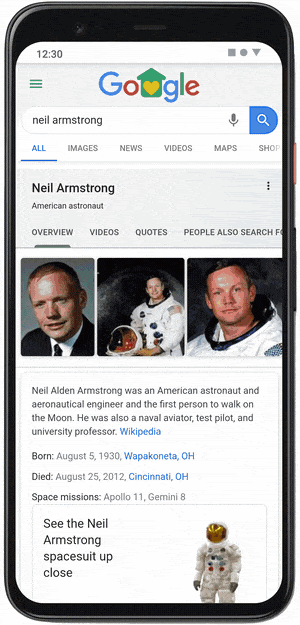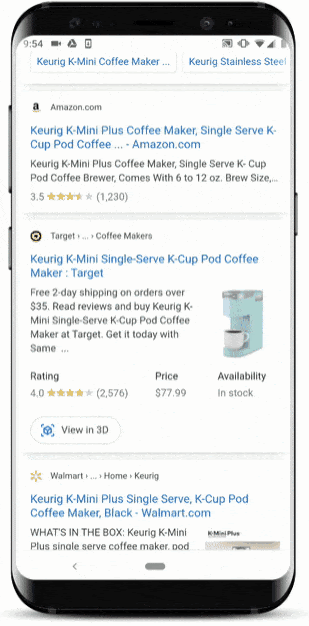Google announced the support for 3D and augmented reality in Search about two years ago. Since then, the list of various living and non-living things (animals, anatomical structures, cultural objects and sites, etc.) that users can view in 3D/AR from every possible angle, has been extended. The way it works is simple and straightforward. Try searching for something on Google:
This feature is available only on mobile devices (Android, iPhone, and iPad).
 |
 |
Source: arvr.google.com/
blog.google/
Sounds fun, and if any object can be displayed in AR, can 3D Search View in Google be implemented for eCommerce products?
Since the launch of 3D and AR Early Adopters Program, Google AR search is also available for eCommerce websites. People can view your content directly from SERP when looking for a specific product brand and model. If you add such a feature to your product cards, the chances that a customer would want to visit your particular website increase significantly. 3D product models in AR provide the level of realism a flat photo won't do, even if it’s of superb quality.
When users click on the View in 3D button, they can either interact with your three-dimensional virtual product or "place" it in their real-world environment with AR. At this point, they can either proceed to your website or return to results page.
Below is an example that illustrates the flow from when a user views a product in 3D/AR and visits the online shop:

Source: developers.google.com
According to Deloitte, the number of AR compatible smartphones and tablets reached more than 1 billion. And within the next year, 100 million buyers are expected to use AR while shopping. So the future where your prospects select a product and interactively change the style, colour, and dimensions of whatever they are looking for, is nearer than you think. 3D Search View for eCommerce sites can have an impact on how you engage with your prospects on Google in the coming years:
Today, the most successful AR experiences can be delivered for retailers who have highly standardised product sets with high opportunity to customise and configure the models for each prospect. For example, positive ROI and spreading adoption of 3D/AR are already present among the automotive and furniture brands.

Source: deloitte.com
Despite its promising benefits, the possibilities of 3D commerce in Search view are not yet available to everyone, and there are several things to consider when deciding whether or not to adopt it on your website:
AR & VR top the list of trends for 2021. Even if you don't do 3D previews for search results, you can still use AR on product cards, with the ability to view products in augmented reality. We wrote about the many opportunities for using AR and WebAR here, and our team is actively engaged in the development and implementation of augmented reality in our clients' projects.
"If you zoom out a little bit, this is visual computing, and it's all driven by 3D content, which will show up in multiple different ways. It's going to take a few years, but we will get to the point where you cannot merchandise a product without it."
—Shrenik Sadalgi, Director of R&D at Wayfair Next, Chair at 3D Commerce Working Group (Khronos Group)
Think about the future of augmented shopping. In a few years, AR product visualisation and personalisation will no longer be a wow factor and a novelty feature to amaze people. It’s quickly becoming an industry standard — as it is the case in the home goods and furniture segment:
“This is where the future is going, and in three years, if you don’t have AR in furniture, you’re going to be looked at as old-school. We’re not waiting. We want to be ahead of all that.”
—VP of digital marketing and omnichannel experience, furniture retailer
Don't be afraid to experiment. The trends clearly show that both the industry and consumers adopt 3D technology. Learn from the industry pioneers how to become niche leaders, and our team will help you in this endeavour — kindly write to us.